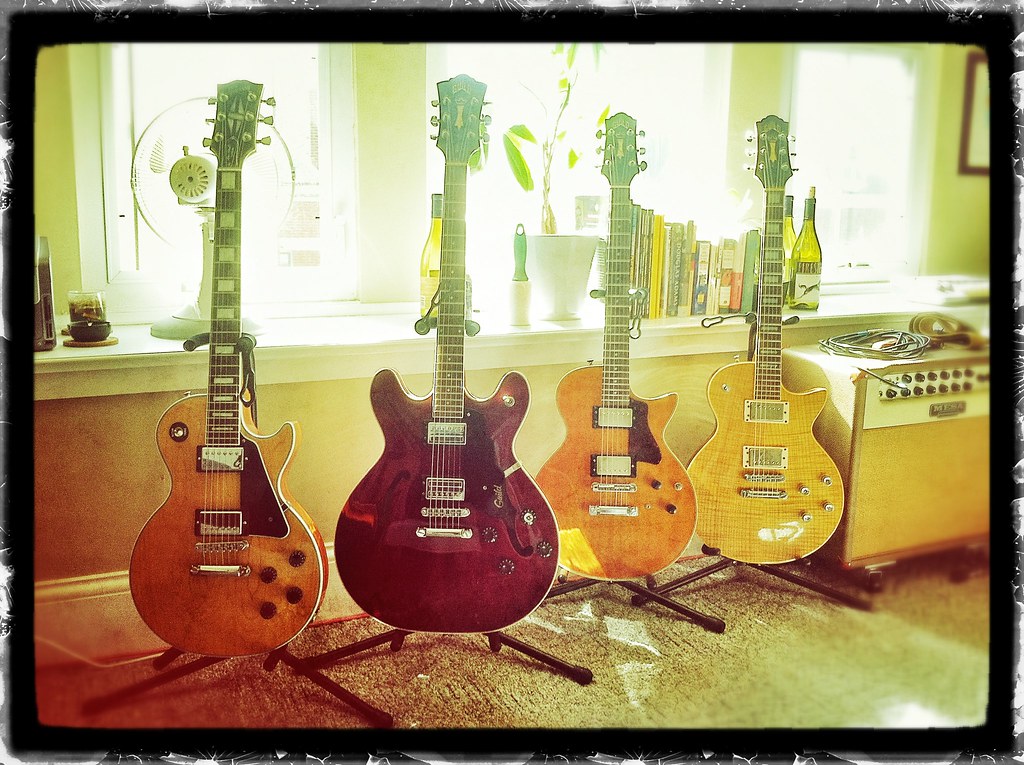I want to apologize up front this time.

I tend to write too much when I get interested in a subject and that sometimes has a chilling effect on other posts. Sorry about that, but I do think I have some points that are worth considering on this subject, so here goes:
In my experience with stop tailpieces, the 'lower' you go, the better single-string playing sounds, though with chord playing, it's just the opposite! I do believe that Increased break-over angle means more felt tension in the string. Whether that means more sustain or not, I honestly don't know. I mean, I
think it does, but I'm not an engineer. Again, I believe that chords sound better when the string tension is
decreased and if chords were more important to me than the single string playing on electric guitars, I would raise the tail-piece on my stop-tailpiece guitars
significantly.
On the issue of strings touching the bridge, it's true you can 'drop' the tailpiece low enough on most stop-tailpiece guitars so that some or all of the strings can lay against the rear-most edge of the (presumably) tune-a-matic bridge. I don't think that's a good thing for a variety of reasons (many pounds of string tension are pushing against the bridge, making the bridge more likely to lean over, affecting intonation and flattening the degree of arc of the radius of the strings, etc.), but all in all, it's a minor problem. Additionally, there's a fix! All you have to do is adjust the tailpiece screws/bolts upwards a bit at a time until you clear the back edge of the bridge and you are in good shape. If you are just talking about some of the lighter strings barely touching the bridge side, by the way, you may not even notice the difference.
By and large, increases or decreases in break-over angle at either the bridge
or the nut make a big difference in how guitars sound.
For instance, guitars that are designed to work with Bigsbys have shallow break-over angles. Why? Because loose strings are easier to manipulate with a Bigsby arm and the bridge is more likely to return to it's original at-rest position if there isn't extra downward string tension from a sharp break-over angle forcing the bridge to 'stay' exactly where the Bigsby function moved it to.
Of course, at some point when the break-over angle becomes too shallow, the guitars lose playability.
For an example, go back to the Bigsby equipped guitars. As the shallow-angled guitars get older, the neck to body angle decreases (due to string-pull issues) and eventually the guitars are less and less playable. That's when you see posts like 'my '60's White Falcon/Starfire III/Duane Eddy DE400's bigsby doesn't work when I drop the action down to a useable level. The usual comments are, 'the strings are too loose', or 'the strings fall off the side of the fingerboard'. Then someone else will suggest heavier strings because they have more tension, but the heavier strings then pull the neck up even more, which only aggravates the symptoms....
Also, think about break-over angle and tension increase
at the nut, too. Any body ever read how the Gibson Company changed their headstock angles in 1965 from a previous angle of 17 degrees to 14 degrees? It was supposed to keep the headstocks from breaking as much, but what it really did was to change the feel of the guitars completely. Guitars with the 14 degree headstock don't sing as much, they are less lively, etc. Finally, Gibson began to change the headstock angle back to 17 degrees in the 1980's.
Okay, let's go to the other end of the guitar and look at things that can effect the break-over angle at the nut. Think about how many wraps you put on a guitar's tuner shaft when you are stringing a guitar. For decades, all my guitar shop luthier-buddies have set up tremelo Strats with a turn and a half of string windings. It makes the string tension loosey-goosey, but there are less wraps to hang up and go out of tune in the tremelo 'dive-bombing' process.
Since I didn't use tremelo much on strats, I tried doing it a little differently and generally use 2.5 to 3.5 turns of windings on the bass strings when stringing up a Strat.
On Teles, without a tremelo, I generally use even more windings. Finally, after years of doing this, I started noticing that my Tele/Strat guitars felt too stiff! Now, I'm going the other way and use less and less windings. I haven't finalized the position yet, but I'm working on it.
Thanks for reading, if you got this far.....

Harry

